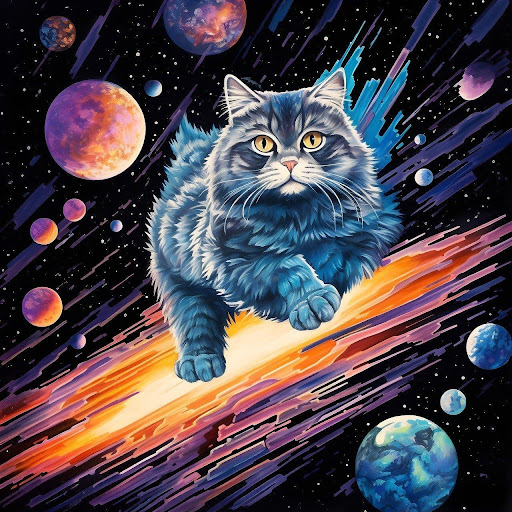While it might seem that cats aren’t very cooperative, they aren’t. It might sound surprising, but humanity sent a cat in space, and this experiment revealed a lot about what it means to survive there. The first cat in space was Félicette, a black and white stray from the streets of Paris. Later on, this cat was sent into our planet’s orbit by the French Center for Education and Research in Aviation Medicine (CERMA), back in the 60s Read on to find out more about her mission and fate.
How long did the cat stay in space?
According to the open sources, Félicette went on a sub-orbital flight mission that lasted only 15 minutes. Her rocket’s engine burned for 42 minutes while ascending. C341, as this cat was named during her mission, went through a 9.5 g-force acceleration. Since the spacecraft’s nose cone separated from the rocket before it reached 152 km height, the cat was weightless for 5 minutes. Félicette stayed in space for about 5 minutes. And unlike human beings who now travel there, she didn’t have a view of our planet from her capsule. During Félicette’s flight, small animal experienced twice the forces that Apollo astronauts experienced during their Moon launches.
What happened to the cat in space?
Before Félicette got into space, CERMA French researchers examined 14 outdoor cats for this experiment. All these cats lived in the best conditions, yet they received numbers instead of names as designations. This way, staff didn’t regard them as their pets and didn’t get emotionally attached to them. To prepare Félicette and the other cats for their mission in space, scientists created serious situations, such as putting them in a compression chamber and a high-gravity centrifuge. They also gave all animals compression garments to limit their movement. Our astronaut cat wasn’t distracted by these conditions and got to be the first cat (and only) to reach our planet’s orbit.
Did Félicette survive?
Félicette, the French cat in space, survived her space journey. According to Orbital Today, she increased her breathing rate during both ascent and descent, but things returned to normal after. Before Félicette, France sent into space only rats. But C341 proved she could go there and come back. During the mission French scientists monitored her breathing and heart rate by implanting electrodes throughout her body.
Sadly, two months after the launch, scientists euthanized Félicette to analyze her brain. Today, she has a statue at the International Space University in Strasbourg, France. Cat’s 5-foot-tall statue designed by sculptor Gill Parker is proof that these animals are not some useless creatures that sleep all day and ask for food.
What Did First Cat in Space Teach Us?
As a 1963 cat in space, Félicette taught us that we can survive in this environment. Without her, humans could not have conducted many space exploration experiments we are conducting today. Her survival means a lot to us, as she paved space exploration way for future French space teams when Véronique AG1, a capsule that carried her 157 km above Earth, brought her back safely.
Félicette’s story, even if indirectly, made its contribution to Apollo Moon missions. If it wasn’t for this cat and other animals, we wouldn’t have known what it means to launch spaceships to the Moon. As mentioned, she remained completely calm when experiencing twice the forces Apollo astronauts experienced during Moon launches. It’s also important to remember that during landing, this little cat experienced 7 g-force until the capsule parachutes opened.
Have Other Cats Been Sent into Space after Félicette?
No. So far, no other cats have been sent into space. Félicette is the only one. There has been another try with another cat, but its rocket crashed due to a malfunction, and that animal died. When the program ended, nine other cats were euthanized. One survived electrode surgery, and scientists made her their mascot. Her name is Scoubidou. Without Félicette and other animals that were involved in this experiment, France would not have claimed an important place in the global space race. CERMA ‘recruited’ 14 cats in total, but Félicette was the only one suitable for space travel.
How Did Humanity Bring Félicette Back to Public Attention?
People forgot all about Félicette, even if she has brought important scientific contributions to the space industry. But in 2017, Matthey Serge Guy launched a Kickstarter campaign to raise the public’s attention to her. Celebrating the contributions she made, people created postage stamps with Félicette’s name. It took some time before her story was revealed to the public and six more decades until she got her bronze statue. The piece was unveiled on December 18, 2019, during the International Space University’s Master of Space Studies Program’s 25th anniversary. After all, Félicette played one of the most important roles in studying the effects of microgravity on mammalian bodies. So, this little cat in space deserves her glory!
Keep an eye for more latest news & updates on Mystories List!
